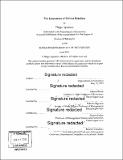| dc.contributor.advisor | Glenn Ellison, Roberto Rigobon and Drazen Prelec. | en_US |
| dc.contributor.author | Aparicio, Diego. | en_US |
| dc.contributor.other | Massachusetts Institute of Technology. Department of Economics. | en_US |
| dc.date.accessioned | 2019-09-17T19:49:03Z | |
| dc.date.available | 2019-09-17T19:49:03Z | |
| dc.date.copyright | 2019 | en_US |
| dc.date.issued | 2019 | en_US |
| dc.identifier.uri | https://hdl.handle.net/1721.1/122232 | |
| dc.description | Thesis: Ph. D., Massachusetts Institute of Technology, Department of Economics, 2019 | en_US |
| dc.description | Cataloged from PDF version of thesis. | en_US |
| dc.description | Includes bibliographical references (pages 161-175). | en_US |
| dc.description.abstract | This thesis consists of four chapters on applied economics related to online retailers. The first chapter studies the impact of targeted price controls on supermarket products in Argentina between 2007 and 2015. Online daily prices for controlled and non-controlled goods were collected to examine the differential effects of the policy on inflation, product availability, entry and exit, and price dispersion. Price controls only have a temporary effect on inflation. Moreover, firms compensate for price controls by introducing new product varieties at higher prices, increasing price dispersion within narrow categories. The second chapter studies choice overload in a large scale online experiment, involving thousands of households making major purchases. Purchase rates and click-through rates decreased with fewer choices. | en_US |
| dc.description.abstract | However, there are heterogeneous effects across users: while local users exhibit lower purchase rates, foreign users exhibit higher purchase rates when offered fewer choices. The third chapter studies the use of online price data to forecast the Consumer Price Index. Online price indices anticipate changes in official inflation trends more than one month in advance. The baseline one-month forecast outperforms Bloomberg surveys of forecasters, which predict the contemporaneous inflation rate. Similarly, online-based quarterly forecasts for the US inflation rate outperform the Survey of Professional Forecasters. The fourth chapter studies pricing in the fashion retail industry. Online data was collected from over 65 retailers in the U.S. and the U.K. A machine learning classifier categorizes products within- and across- retailers, as well as over different seasons. | en_US |
| dc.description.abstract | A fair fraction of firms implements what is described as price clustering: a large number of different products are priced using just a small number of sparse prices, with price changes occurring rarely and in large increments. This pricing strategy is consistent with a behavioral model where fewer prices makes price advertising more effective. | en_US |
| dc.description.statementofresponsibility | by Diego Aparicio. | en_US |
| dc.format.extent | 175 pages | en_US |
| dc.language.iso | eng | en_US |
| dc.publisher | Massachusetts Institute of Technology | en_US |
| dc.rights | MIT theses are protected by copyright. They may be viewed, downloaded, or printed from this source but further reproduction or distribution in any format is prohibited without written permission. | en_US |
| dc.rights.uri | http://dspace.mit.edu/handle/1721.1/7582 | en_US |
| dc.subject | Economics. | en_US |
| dc.title | The economics of online retailers | en_US |
| dc.type | Thesis | en_US |
| dc.description.degree | Ph. D. | en_US |
| dc.contributor.department | Massachusetts Institute of Technology. Department of Economics | en_US |
| dc.identifier.oclc | 1119388923 | en_US |
| dc.description.collection | Ph.D. Massachusetts Institute of Technology, Department of Economics | en_US |
| dspace.imported | 2019-09-17T19:49:01Z | en_US |
| mit.thesis.degree | Doctoral | en_US |
| mit.thesis.department | Econ | en_US |
